If you’ve been roaming the net for information about gun safes, your research has likely pointed you towards a lot of sites mentioning dehumidifiers. It might sound out of place when you’re talking about a gun safe, but in fact it’s very important. In this section of the gun safe buyers guide, we’ll talk about dehumidifiers; what they are and how to pick one out.
What does a dehumidifier do?
A: The purpose of a dehumidifier is to eliminate condensation from forming inside the gun safe. Condensation can cause metal to rust and can leave your safe with a nasty smell. Depending on where your safe is located and what your climate is like, condensation can form inside a safe due to the change in temperature or in areas of high humidity.
What are the different types of dehumidifiers?
A: There are two main types of dehumidifiers for gun safes. An electric and a desiccant. The desiccant dehumidifier works great in safes that are not near an electrical outlet. Desiccant is a hygroscopic substance that has the ability to attract water molecules from the surrounding environment through absorption. The desiccant needs to be recharged after it’s absorbed all that it can. This is usually a period of 2-6 months, depending on the brand and how much it’s being used. The desiccant can be recharged in your oven so it can be used over and over.
The electric dehumidifier is the more popular of the two. This dehumidifier, also known as a “Golden Rod”, heats to a surface temperature of about 140 degrees. Its purpose is to maintain a constant temperature throughout your safe. Maintaining a warm temperature in the safe lessens the chance that water vapor will condense and promote rust. It usually comes in the form of an 18″ rod that can be mounted to the floor or wall of your safe. Installation is easy: The cord is removable so you can wire it through your safe and plug it in. To take up even less space, there is a flexible dehumidifier as well. This one can be bent to contour the corner of your safe.
Do I need a dehumidifier?
A: This is a tricky question. If the safe is going to be located in a climate controlled area like your home, it may not need a dehumidifier. If the door is opened often enough, this will also help prevent condensation. However, in some areas of high humidity, even a safe that is placed inside a home can collect condensation. It might be best to call a GunSafes.com rep to speak about your particular situation.
If the safe is going to be placed in your garage, basement, or any area that does not have a controlled climate, I would recommend a dehumidifier. The temperature change in these areas can cause condensation in the safe which will result in rust forming on your precious guns!
Which dehumidifier is right for me?
A: First you’ll need to choose between electric and desiccant. If you have the electrical outlet available, I would go that route. Make sure the safe you are buying or the safe you own has a hole in the back to pass the cord through. If not, you’ll want the desiccant. Some people even feel the need to combine the strength of the electric with the dependability of the cordless desiccant. That way if they are away on a trip and the power goes out, they know that their precious items will be protected. Some people even double up and get two dehumidifiers if they live in an area of extremely high humidity. It’s all about your individual situation.

